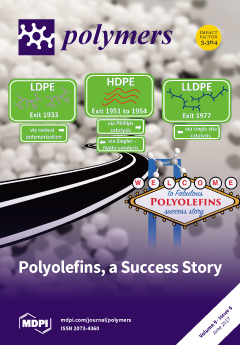Through the reversible addition–fragmentation chain transfer (RAFT) copolymerization of 3-ethyl-1-vinyl-2-pyrrolidone (C
2NVP) and
N-vinylpyrrolidone (NVP), a series of well-defined P(C
2NVP-
co-NVP) copolymers were synthesized (
Mn = ca. 8000 to 16,000 and
Mw/Mn <1.5)
[...] Read more.
Through the reversible addition–fragmentation chain transfer (RAFT) copolymerization of 3-ethyl-1-vinyl-2-pyrrolidone (C
2NVP) and
N-vinylpyrrolidone (NVP), a series of well-defined P(C
2NVP-
co-NVP) copolymers were synthesized (
Mn = ca. 8000 to 16,000 and
Mw/Mn <1.5) by using a difunctional chain transfer agent,
S-(1-methyl-4-hydroxyethyl acetate)
O-ethyl xanthate (MHEX). Copolymerizing kinetics and different monomer ratio in feeds were conducted to study the apparent monomer reaction rate and reactivity ratios of NVP and C
2NVP, which indicated similar reaction rates and predominantly ideal random copolymers for the two monomers. The
Tgs of the obtaining P(C
2NVP-
co-NVP) copolymers significantly corresponded to not only molecular weights MWs but also copolymer compositions. These copolymers presented characteristic lower critical solution temperatures (LCST) behavior. We then studied the cloud points (CPs) of the copolymers with varying MWs and compositions. With different MWs, the CPs were linearly decreased from ca. 51 to 45 °C. With different compositions, the CPs of the copolymers decreased from ca. 48 to 29 °C with C
2NVP content (i.e., from 60.8 to 89.9 mol %). Fitting the CPs by the theoretical equation, the result illustrated that the introduction of more hydrophobic units of C
2NVP suppressed the hydrophilic interaction between the polymer chain and water. We then successfully proceeded the chain extension through the ring-opening polymerization (ROP) of ε-caprolactone (CL) to the synthesis of a novel P(C
2NVP-
co-NVP)-
b-PCL amphiphilic block copolymer (
Mn,NMR = 14,730 and
Mw/
Mn = 1.59). The critical micelle concentration (CMC) of the block copolymer had a value of ca. 1.46 × 10
−4 g/L. The block copolymer micelle was traced by dynamic light scattering (DLS), obtaining thermosensitive behaviors with a particle size of ca. 240 nm at 25 °C and ca. 140 nm at 55 °C, respectively.
Full article






